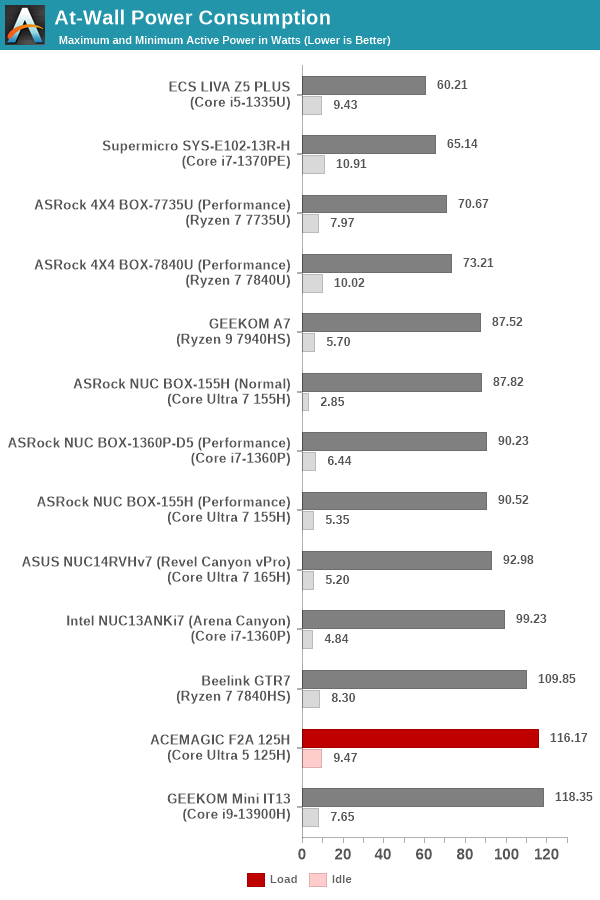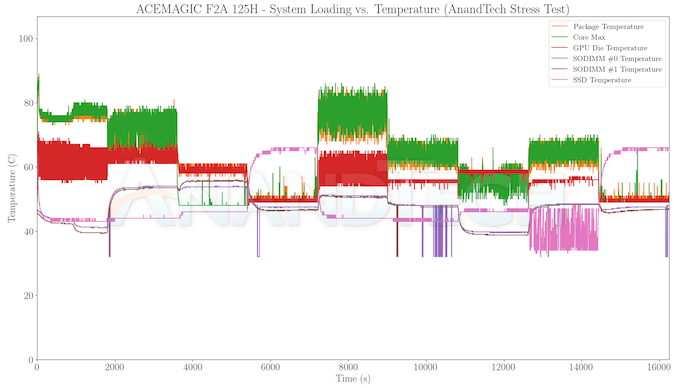ACEMAGIC F2A 125H SFF PC Review: Mid-Range Meteor Lake at 65W
by Ganesh T S on August 26, 2024 8:00 AM EST- Posted in
- Systems
- Intel
- SFF
- Mini-PC
- Meteor Lake
- AceMagician
Power Consumption and Thermal Characteristics
The power consumption at the wall was measured with a 4K display being driven through one of the HDMI ports of the system. In the graph below, we compare the idle and load power of the ACEMAGIC F2A 125H with other systems evaluated before. For load power consumption, we ran the AIDA64 System Stability Test with various stress components, as well as our custom stress test with Prime95 / Furmark, and noted the peak as well as idling power consumption at the wall.

The numbers are consistent with the TDP and suggested PL1 / PL2 values for the processors in the systems, and do not come as any surprise. With a 90W PL2 setting, we find the peak power consumption of the F2A 125H to be around 116W. Idle numbers could be a bit better with some BIOS optimizations.
Stress Testing
Our thermal stress routine is a combination of Prime95, Furmark, and Finalwire's AIDA64 System Stability Test. The following 9-step sequence is followed, starting with the system at idle:
- Start with the Prime95 stress test configured for maximum power consumption
- After 30 minutes, add Furmark GPU stress workload
- After 30 minutes, terminate the Prime95 workload
- After 30 minutes, terminate the Furmark workload and let the system idle
- After 30 minutes of idling, start the AIDA64 System Stress Test (SST) with CPU, caches, and RAM activated
- After 30 minutes, terminate the previous AIDA64 SST and start a new one with the GPU, CPU, caches, and RAM activated
- After 30 minutes, terminate the previous AIDA64 SST and start a new one with only the GPU activated
- After 30 minutes, terminate the previous AIDA64 SST and start a new one with the CPU, GPU, caches, RAM, and SSD activated
- After 30 minutes, terminate the AIDA64 SST and let the system idle for 30 minutes
Traditionally, this test used to record the clock frequencies - however, with the increasing number of cores in modern processors and fine-grained clock control, frequency information makes the graphs cluttered and doesn't contribute much to understanding the thermal performance of the system. The focus is now on the power consumption and temperature profiles to determine if throttling is in play.
The thermal solution of the F2A 125H is good enough to let the processor package operate with a sustained 65W package power. We see that the number stays right around that mark all through the segments where the CPU is stressed. Additionally, the core temperature never crosses 85C throughout this duration. The SSD temperature goes up to 64C under heavy stress, but stays as cool as 40C during other periods. The SODIMMs also stay well south of 60C in the whole process.
Real-World Thermals and Power Consumption
Beyond the extreme synthetic tests above, it is also useful to get an ideal of the thermal behavior and power consumption numbers for common consumer workloads. For this purpose, we again turn to UL's Procyon benchmark. Results from the benchmark were presented in a previous section. In this sub-section, results gathered from the simultaneous built-in system monitoring thread are presented.
| UL Procyon Office Workload Package Temperature and At-Wall Power Consumption |
||||
| System | Cores Temperature (C) | At-Wall Power (Average) (W) |
||
| Minimum | Average | Maximum | ||
| ASRock NUC BOX-155H (Performance) | 42 | 55.36 | 93 | 29.41 |
| ACEMAGIC F2A 125H | 27 | 33.42 | 64 | 26.58 |
| ASUS NUC14RVHv7 (Revel Canyon vPro) | 41.01 | 51.41 | 85 | 28.02 |
| ASRock NUC BOX-155H (Normal) | 45 | 58.1 | 98.61 | 27.02 |
The delta in the average power consumption at the wall is less than 3W for the F2A 125H, but this translates to a delta of more than 21C for the maximum temperature in the Office workload case.
| UL Procyon Photo Processing Package Temperature and At-Wall Power Consumption |
||||
| System | Cores Temperature (C) | At-Wall Power (Average) (W) |
||
| Minimum | Average | Maximum | ||
| ASRock NUC BOX-155H (Performance) | 44 | 63.92 | 110 | 40.58 |
| ACEMAGIC F2A 125H | 27.6 | 37.11 | 68.09 | 37.7 |
| ASUS NUC14RVHv7 (Revel Canyon vPro) | 42 | 59.43 | 111.69 | 42.17 |
| ASRock NUC BOX-155H (Normal) | 47 | 64.38 | 109.91 | 35.34 |
A similar trend is seen for the photo processing workload, with the maximum temperature being south of 70C for the ACEMAGIC system.
| UL Procyon Video Processing Package Temperature and At-Wall Power Consumption |
||||
| System | Cores Temperature (C) | At-Wall Power (Average) (W) |
||
| Minimum | Average | Maximum | ||
| ASRock NUC BOX-155H (Performance) | 45 | 77.19 | 110 | 47.39 |
| ACEMAGIC F2A 125H | 28 | 40.32 | 60.98 | 43.14 |
| ASUS NUC14RVHv7 (Revel Canyon vPro) | 49 | 68.17 | 101 | 51.17 |
| ASRock NUC BOX-155H (Normal) | 50 | 71.75 | 106.91 | 40.45 |
The F2A 125H again hits it out of the park with a 61C peak temperature in the video processing workload.
The larger physical footprint enables a much better thermal solution for the ACEMAGIC F2A 125H compared to the 4x4 systems. This is reflected very well in the real world thermal characteristics and also backs up our inferences from the synthetic stress tests sequence.












11 Comments
View All Comments
meacupla - Monday, August 26, 2024 - link
It is amazing what a few extra cm of space does for the thermals.Bonus points for 2x2280 storage, but I wish it supported 3x2280 or 2x22110
AdrianBc - Tuesday, August 27, 2024 - link
I agree with you, which is why I have liked a NUC-like computer with Ryzen AI 3xx that is expected to be launched in October and for whom some preliminary tests of a prototype have been shown on Youtube and linked on various sites with computer news.That computer has 3 M.2 2280 sockets, replacing the traditional NUC configuration with 1 M.2 2280 socket + 2 SODIMM sockets.
This was possible because the SODIMM sockets were replaced with faster soldered LPDDRX memory, selectable as 16 GB, 32 GB or 64 GB.
I have been using a lot of NUC-like computers for many years, and in my opinion for such computers it is far more useful to be able to install three full-size SSDs, than to be able to replace the DRAM. Therefore I approve the choice made by the designers of that computer.
Hulk - Monday, August 26, 2024 - link
If it is running 4.5GHz during CB R23 ST then that result it horrendous. Like 20% lower IPC-wise (throughput) than a similarly clocked Raptor Cove core.Techie4Us - Monday, August 26, 2024 - link
Design, features & thermals good, low-tier ram & dram-less SSD.....not so much, especially at this price point....If they offered a barebones unit for like ~$400, I might be interested, otherwise..pass....
Also the spec sheet says " OS = W11 Enterprise", then the pricing part right under that says "W11 HOME"... so which is it and how much difference does this make in the price ?
ganeshts - Tuesday, August 27, 2024 - link
ACEMAGIC sells the system with Win 11 Home pre-installed.However, when we test mini-PCs, we always wipe and install Windows 11 Enterprise. It just gives us more features to customize the behavior and prevent surprises while benchmarking.
The pricing includes the license for Win 11 Home (and that is why the mention of the Home variant is in the Pricing entry).
meacupla - Tuesday, August 27, 2024 - link
IDK what you consider "high-tier ram", but DDR5 SODIMM maxes out at 5600.eastcoast_pete - Monday, August 26, 2024 - link
Ganesh's advice about wiping the drive and do a complete new install of the OS before usw is, unfortunately, spot on. Other sites and reviewers had found potential malware / spyware on at least one Acemagic mini-PC they evaluated. Acemagic did respond very quickly and tried to explain it away, but Ganesh is 100% correct in pointing out that wiping the drive and a fresh reinstall of the OS is the safe thing to do.haplo602 - Tuesday, August 27, 2024 - link
Why would anybody buy Intel based miniPCs is beyond my understanding. Unless you need Quicksync the AMD based ones are overall better.nandnandnand - Tuesday, August 27, 2024 - link
Meteor Lake-H has improved integrated graphics considerably. But it all comes down to price in the end.haplo602 - Wednesday, August 28, 2024 - link
Given what I have seen with the MSI Claw, it also has terrible power management/distribution between the CPU anf GPU ...